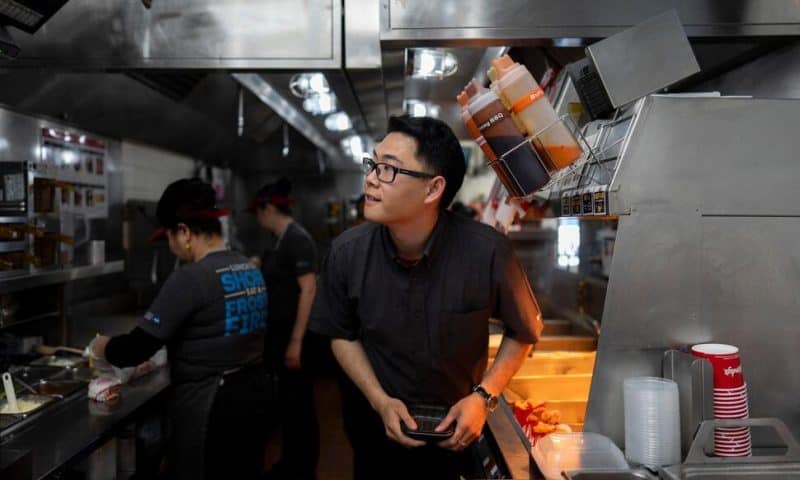When California’s minimum wage increase went into effect in April, fast food workers across the state went from making $16 to $20 overnight
LOS ANGELES — Lawrence Cheng, whose family owns seven Wendy’s locations south of Los Angeles, took orders at the register on a recent day and emptied steaming hot baskets of French fries and chicken nuggets, salting them with a flourish.
Cheng used to have nearly a dozen employees on the afternoon shift at his Fountain Valley location in Orange County. Now he only schedules seven for each shift as he scrambles to absorb a dramatic jump in labor costs after a new California law boosted the hourly wage for fast food workers on April 1 from $16 to $20 an hour.
“We kind of just cut where we can,” he said. “I schedule one less person, and then I come in for that time that I didn’t schedule and I work that hour.”
Cheng hopes the summer when business is traditionally brisk with students out of school and families traveling or spending more time eating out will bring a better profit that can cover the added costs.
Experts say it’s still too early to tell the long-term impact of the wage hike on fast food restaurants and whether there will be widespread layoffs and closures. Past wage increases have not necessarily led to job losses. When California and New York nearly doubled their minimum wage previously to $15 compared to the federal level of $7.25 per hour, job growth continued, according to a University of California, Berkeley study.
So far, the industry has continued to show job growth. In the first two months after the law passed April 1, the industry gained 8,000 jobs, compared to the same period in 2023, according to the U.S. Bureau of Labor Statistics. No figures were available yet for June.
Joseph Bryant, executive vice president of the Service Employees International Union, which pushed for the raise, said the industry has not only added jobs under the new law but “multiple franchisees have also noted that the higher wage is already attracting better job candidates, thus reducing turnover.”
But many major fast food chain operators say they are cutting hours and raising prices to stay in business.
“I’ve been in the business for 25 years and two different brands and I never had to increase the amount of pricing that I did this past time in April,” Juancarlos Chacon, an owner of nine Jersey Mike’s in Los Angeles, said.
A turkey sub for under $10? It’s now $11.15. While customers are still coming in, he’s seeing them cut back — no drinks, no chips, no dessert.
Since their core business is lunch, Chacon has been reducing staffing in the mornings and evenings. He’s also cut a few part-time employees, going from 165 total to about 145.
It wasn’t only entry-level workers that got a pay raise. Shift leaders, assistant managers, and everyone else up the ladder had to get raises too, and labor represents about 35% of his costs.
“I’m very nervous,” Chacon said.
Aaron Allen, founder and CEO of a global restaurant consulting firm, said he’s gotten panicked calls from California restaurant operators and suppliers that are still recovering from the COVID-19 lockdown. He predicts a growing divide between corporations like McDonalds that have money to invest in automation and reduce costs through “menu reconfiguration, versus smaller, more regional chains that might go under or face a major reduction in stores.”
Cheng said he has no plans to lay off any of his 250 Wendy’s workers and instead has turned to cutting overtime and reducing the amount of workers on each shift. He also raised menu prices about 8% in January in anticipation of the law.
Still he said his books show that he was $20,000 over budget for a two-week pay period.
Jot Condie, president and CEO of the California Restaurant Association, which opposed the minimum wage bill, said businesses are simultaneously feeling the squeeze from rising rents and food costs.
“When labor costs jump more than 25% overnight, any restaurant business with already-thin margins will be forced to reduce expenses elsewhere,” Condie said. “They don’t have a lot of options beyond increasing prices, reducing hours of operation, or scaling back the size of their workforce.”
Julieta Garcia, who’s been at a Pizza Hut in Los Angeles for a little over a year, said she’s now working five days instead of six. But that’s not a bad thing, she said, since she can spend more time with her 4-year-old son. The extra money means she can pay her cellphone bill on time, instead of having to turn off service, and take her son to get his tonsils checked out, she said.
Howard Lewis, a 63-year-old retiree who works at a Wendy’s in Sacramento, said he has been investing his extra money.
“Today was payday and I bought $500 worth of stock,” said Lewis. He’s also helping his ex-wife fix the brakes on her car.
Gov. Gavin Newsom said the hike was necessary to give the state’s more than half a million fast food workers a living wage.
“We are a state that gives a damn about fast food workers — who are predominantly women — working two and a half jobs to get by,” Newsom stated in his state-of-the-state address posted on social media.
For Enif Somilleda, a general manager at a Del Taco in Orange County, the raise has been a mixed bag. She used to have four people working per shift. She now only has two.
“Financially it has helped me,” she said. “But I have less people so I have to do a lot more work.”

